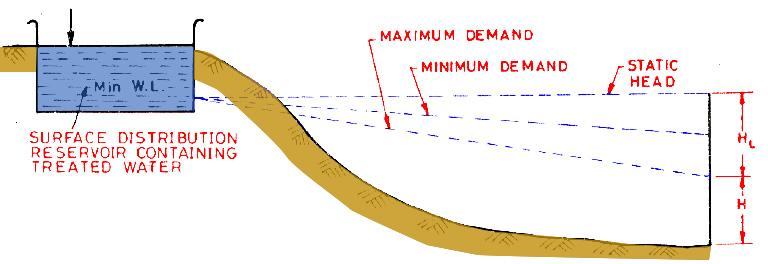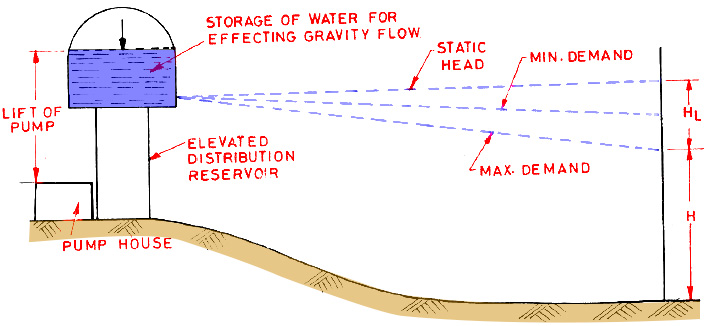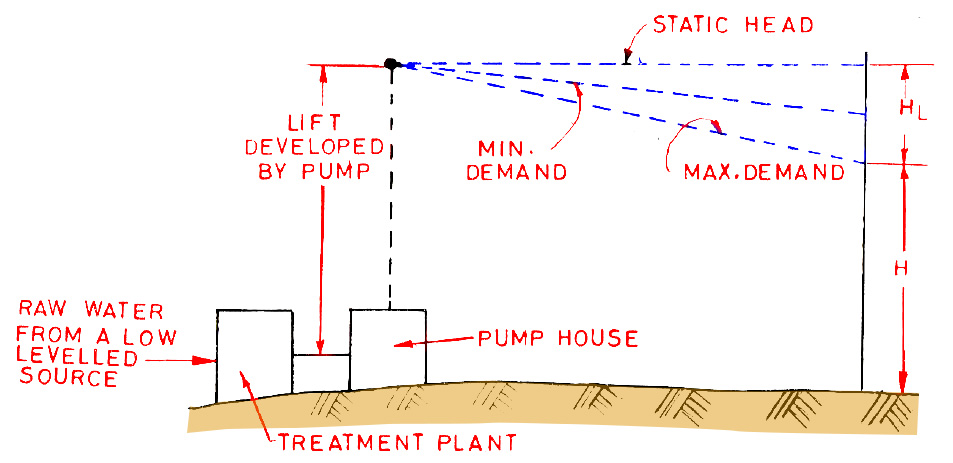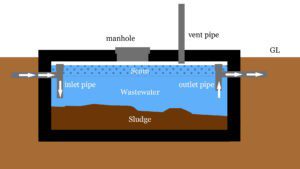There are several layouts of the distribution system of water depending upon the developed condition of the cities. However, to make efficient use of the proposed layout, it becomes very crucial to understand the location of the water sources. This factor plays a significant role in determining the adoption of various water distribution methods or methods of water distribution. As such, the focus of this article is to explore and discuss the different methods of water distribution. By examining these methods, readers will gain valuable insights into optimizing the distribution system and ensuring the efficient delivery of water to meet the needs of urban areas.
Different Methods of Water Distribution
The primary goal for adopting different methods of water distribution systems is to ensure optimal water pressure is achieved at different points where consumers access water. This objective is influenced by factors such as the water source’s elevation in relation to the city, the local topography, and other location-specific conditions. To accomplish this, water can be propelled into the distribution system through any of the following three methods:
- By gravitational system
- By pumping system
- by combined system
Gravitation System
This gravity-based water distribution system eliminates the need for pumping by utilizing the natural flow from higher-level sources to lower-level consumers. It requires a sufficient elevation difference between the water source and the localities to maintain an ample water supply at the doorsteps, considering pipe losses. This method is both cost-effective and dependable since pumping is completely avoided. Cities located in foothill areas with a suitable elevation difference between their water source and the city can adopt this system for their water supply.
In some cases, if a lake is situated on a hill and the treatment plant is also located at a similar level on the hill itself, then the water may need to be conveyed from the source to the treatment plant using low lift pumping. However, the system ensures that the treated water is distributed to low-level consumers situated at the foothill by mere gravity, thereby eliminating the need for pumping in the distribution system.
The gravitational system is designed to allocate only the minimum permitted available head to the consumers, with the remaining head being consumed by frictional and other losses. This design minimizes leakages and wastage while reducing the required size of the pipes. Consequently, a greater head load (HL) reduces the required diameter of the pipe to pass a given discharge. However, motor pumps need to be used to develop sufficient pressure during fires.

Also, read: Water Quality Parameters: Importance of Quality of Water?
Pumping System
The pumping system operates by directly pumping the treated water into the distribution mains without storing it elsewhere. Hence, it is also referred to as a pumping without a storage system. This system requires high-lift pumps that can adjust their speeds to meet the varying water demand. As a result, constant monitoring is necessary at the pumping station to ensure the desired flow in the distribution system.
In the event of a power failure, the water supply would come to a complete halt, which could be disastrous if a fire were to occur during that time. Due to these limitations, this method is generally not favoured. However, the only advantage it offers is the ability to generate a large volume of water at high pressure in a specific direction during fires, potentially eliminating the need for additional motor pumps.

Combined Gravity and Pumping System:
In this system, the treated water is consistently pumped and stored in an elevated distribution reservoir. From there, it is distributed to consumers purely through gravity. Depending on the situation, the water may either be pumped solely into the distribution reservoir or simultaneously into the distribution mains and reservoirs. This method combines both pumping and gravity flow, often referred to as pumping with the storage system.
During periods of low water demand, any excess water is stored in the reservoir to be utilized during periods of high demand. The pumps are operated at a constant rate, adjusted in a manner that ensures the surplus water stored in the reservoir during low consumption is nearly equal to the additional demand during high consumption. This system enables the pumps to maintain constant speeds at their rated capacities, resulting in increased efficiency and reduced wear and tear.

Advantages of Combined Gravity and Pumping System
This type of system is universally adopted and remains consistent due to its numerous advantages:
- The distribution reservoir’s reserve can be utilized to supply water in the event of a fire. If necessary, the required pressure for firefighting can be achieved by either closing off supply to certain areas or utilizing motor pumps. As a result, modern firefighting squads are equipped with motor pumps.
- The pumps operate at a steady rate, allowing them to function at their rated capacities. This enhances their efficiency, and the supervision required for pump operation is significantly reduced compared to variable speed operation. In smaller towns, this distribution method enables pumps to be operated for a limited duration, typically 8 to 16 hours per day.
- The system is highly reliable because, even during a power failure, a certain amount of water can still be supplied from storage or service reservoirs.
- Overall, this system proves to be cost-effective, efficient, and reliable, making it the preferred choice in almost every location.
System of Water Supply
There are generally two types of systems of water supply to consumers adopted either due to excess or inadequate water in the water supply. The two systems are as:
- Continuous system
- Intermittent System
Continuous System:
The continuous system ensures that consumers have access to water 24 hours a day. Undoubtedly, this is considered the ideal system as it provides water whenever needed. However, this unrestricted availability can result in wasteful water usage. Any minor leakages or issues in the system can lead to a significant volume of water being wasted due to the extended duration of flow. Therefore, this system can only be implemented when an ample water supply is available. One advantage of this system is that water remains in constant motion within the pipes, preventing stagnation and ensuring a continuous supply of fresh water.
Also, read: Concrete Pipes: Advantages And Disadvantages Of Concrete Pipe
Intermittent System:
In this system, water is exclusively provided to consumers during fixed hours of the day, typically spanning two to four hours in the morning and two to four hours in the evening. This approach is commonly practised in India and neighbouring countries like Bhutan, Nepal, and Bangladesh. It is implemented when either there is insufficient pressure or an insufficient quantity of water available. In such cases, different zones within the city are supplied with water in a rotational manner. The regular supply timings typically range from 6 AM to 10 AM and 4 PM to 8 PM, although these timings may be adjusted to accommodate climatic or seasonal conditions.
Drawbacks for Intermittent System
- Fire demand. It is difficult to control the fire back out and rescue operation becomes difficult. The water cannot be brought on time from other zones as quickly as needed and fire damage will be more.
- Domestic storage. The intermittent system requires the provision of small storage tanks in individual houses so that sanitary fittings in the house can work effectively during periods of no supply.
- Pollution in Supply: During the non-supply period, the pressure in the supply line may fall below atmospheric pressure. This may induce suction through leaking joints. When the pipeline is laid near the sewer etc. this may lead to severe pollution and contamination problems.
- Size of pipes: The greater size of pipes will be required since the supply for the whole day has to be made in a shorter period.
- Wastage from water taps: During the non-supply of period, the water taps may be left open unknowingly or due to negligence. This will lead to a large waste of water during the supply period.
- Increase employment: There will be a requirement for additional employment to operate and maintain additional fittings such as valves.
Also, read: Cast Iron Pipe – Advantages And Disadvantages
References:
- Garg, S.K. (2010). Environmental Engineering. Vol.-I. Water Supply Engineering (35th ed.). Khanna Publishers. Daryaganj, New Delhi-110002.
- Punmia. B.C, Jain. A & Jain. A. (2005)Water Supply Engineering (2nd ed). Laxmi Publications (P) Ltd. New Delhi.
![]()







